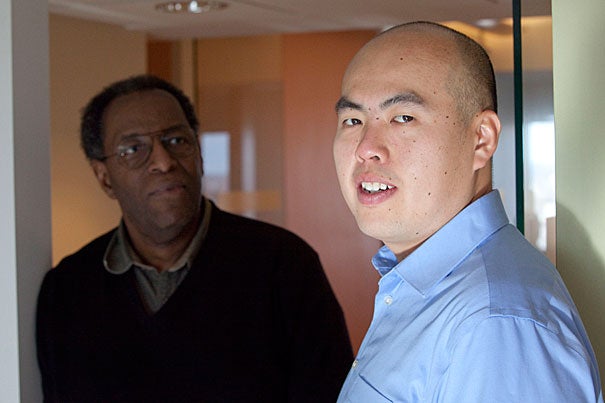
Arnold K. Ho (right), a Ph.D. student in psychology at Harvard, and James Sidanius, a professor of psychology and of African and African-American studies at Harvard, researched the “one-drop rule.” They say their work reflects the cultural entrenchment of America’s traditional racial hierarchy, which assigns the highest status to whites, followed by Asians, with Latinos and blacks at the bottom.
Kris Snibbe/Harvard Staff Photographer
‘One-drop rule’ persists
Biracials viewed as members of their lower-status parent group
The centuries-old “one-drop rule” assigning minority status to mixed-race individuals appears to live on in our modern-day perception and categorization of people like Barack Obama, Tiger Woods, and Halle Berry.
So say Harvard University psychologists, who’ve found that we still tend to see biracials not as equal members of both parent groups, but as belonging more to their minority parent group. The research appears in the Journal of Personality and Social Psychology.
“Many commentators have argued that the election of Barack Obama, and the increasing number of mixed-race people more broadly, will lead to a fundamental change in American race relations,” says lead author Arnold K. Ho, a Ph.D. student in psychology at Harvard. “Our work challenges the interpretation of our first biracial president, and the growing number of mixed-race people in general, as signaling a color-blind America.”
In the United States, the “one-drop rule” — also known as hypodescent — dates to a 1662 Virginia law on the treatment of mixed-race individuals. The legal notion of hypodescent has been upheld as recently as 1985, when a Louisiana court ruled that a woman with a black great-great-great-great-grandmother could not identify herself as “white” on her passport.
“One of the remarkable things about our research on hypodescent is what it tells us about the hierarchical nature of race relations in the United States,” says co-author James Sidanius, professor of psychology and of African and African-American studies at Harvard. “Hypodescent against blacks remains a relatively powerful force within American society.”
Ho and Sidanius, along with co-authors Mahzarin R. Banaji at Harvard and Daniel T. Levin at Vanderbilt University, say their work reflects the cultural entrenchment of America’s traditional racial hierarchy, which assigns the highest status to whites, followed by Asians, with Latinos and blacks at the bottom.
Ho and colleagues presented subjects with computer-generated images of black-white and Asian-white individuals, as well as family trees showing different biracial permutations. They also asked people to report directly whether they perceived biracials to be more minority or white. By using multiple approaches, their work examined both conscious and unconscious perceptions of biracial individuals, presenting the most extensive empirical evidence to date on how they are perceived.
The researchers found, for example, that one-quarter-Asian individuals are consistently considered more white than one-quarter-black individuals, despite the fact that African Americans and European Americans share a substantial degree of genetic heritage.
Using face-morphing technology that presented a series of faces ranging from 5 percent white to 95 percent white, they also found that individuals who were a 50-50 mix of two races, either black-white or Asian-white, were almost never identified by study participants as white. Furthermore, on average, black-white biracials had to be 68 percent white before they were perceived as white; the comparable figure for Asian-white biracials was 63 percent.
“The United States is already a country of ethnic mixtures, but in the near future it will be even more so, and more so than any other country on earth,” says Banaji, Richard Clarke Cabot Professor of Social Ethics at Harvard. “When we see in our data that our own minds are limited in the perception of those who are the products of two different ethnic groups, we recognize how far we have to go in order to have an objectively accurate and fair assessment of people. That’s the challenge for modern minds.”
The team found few differences in how whites and non-whites perceive biracial individuals, with both assigning them with equal frequency to lower-status groups. The researchers are conducting further studies to examine why Americans continue to associate biracials more with their minority parent group.
“The persistence of hypodescent serves to reinforce racial boundaries, rather than moving us toward a race-neutral society,” Ho says.
The research was supported by the Harvard University Anderson Fund.




